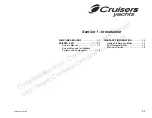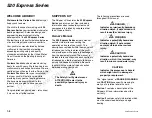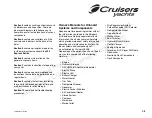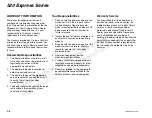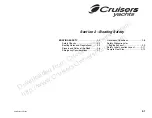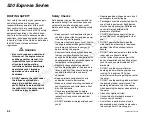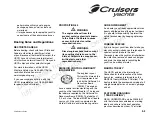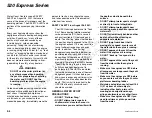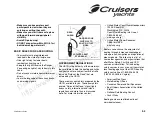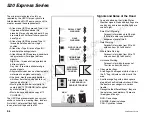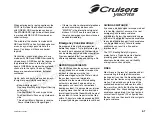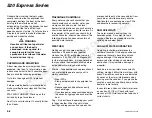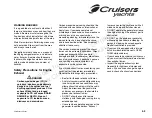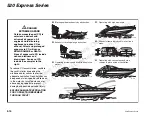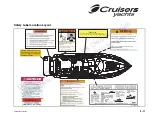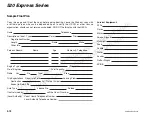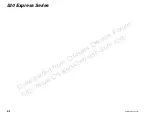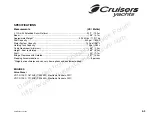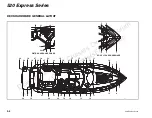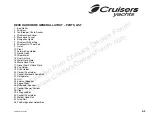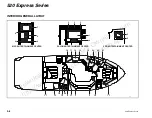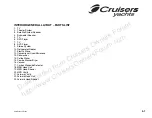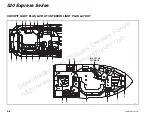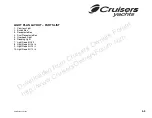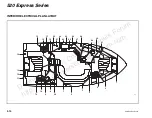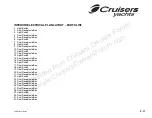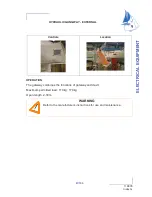
2-8
520 Express Series
520 Express Series
Onboard fires involving the fuel system
usually result in either an explosion that
completely destroys the boat, or the boat
burning to the waterline and self
extinguishing. Deciding to abandon the boat
or stay to fight the fire is difficult and
depends on many factors. Try to formulate a
fire plan in advance to make that decision
quickly and without hesitation.
WARNING
Gasoline will float on top of water
and can burn. If the boat is
abandoned, swim up wind, far
enough to avoid fuel that may
spread over the surface of the water
to avoid serious injury.
CAPSIZING AND SWAMPING
A boat may capsize or swamp when least
expected. Like fires, try to formulate a plan
in advance on what to do if it should happen.
Keep in mind the following guidelines:
Try to turn the engines OFF to prevent
damage.
If others were onboard, try to locate them,
make sure they’re conscious and that they
can swim.
STAY WITH THE BOAT! Climb up on the
hull and try to get assistance.
Don’t try to swim to shore. It’s usually further
than it looks.
Hazardous Conditions
Every waterway poses hazards that you
should avoid such as shallow water, tree
stumps and sand bars, etc. Ask local
boaters for information and consult a marine
chart when boating on unfamiliar waters. As
the operator of the yacht, you should try to
avoid all hazards, known and unknown. The
following information does not contain all
possible water hazards.
WEATHER
Getting caught in severe weather is
hazardous. Check with local weather
stations, the USCG, or Weather service
broadcasts (162.55 or 162.40 Megahertz)
for the latest conditions. It is recommended
that you check the weather not only before
but periodically while you are boating.
Storms – Take common sense precautions if
you are forced to operate your yacht in
stormy conditions:
• Wear PFDs
• Stow gear below and lash equipment on
deck.
• Reduce speed and head for an easily
reached refuge.
• If you lose power, keep yacht headed into
the waves by rigging a sea anchor off the
bow.
Fog – It is best to avoid operating your yacht
in foggy weather. When fog sets in take
bearings and log courses and speeds. You
are required to emit a five second blast from
your horn or whistle once every minute.
Additionally, have passengers wear PFDs
and observe for oncoming vessels.
DAM SPILLWAYS
The water around a dam spillway is a
hazardous area. It is subject to rapid
changes. Boaters must keep clear of the
spillway areas below dams.
SHALLOW WATER OPERATION
Operating in shallow water presents a
number of hazards. If the engine strikes an
underwater hazard, check for yacht and
engine damage. If the engine vibrates
excessively after striking an underwater
obstruction, it may indicate a damaged
propeller.
Sand bars in narrow inlets are constantly
shifting, making it difficult to mark them with
buoys. Sometimes, sand bars are indicated
by waves as they form into breakers when
passing over the sand bar. If you ground the
yacht on a sand bar, seek help from another
boater or radio for help.
In coastal areas, tides can affect water level
as much as 30 ft (9 m) Check with local
marinas or USCG stations for tide tables and
current charts.
Downloaded
from
Cruisers
Owners
Forum
http://www.CruisersOwnersForum.com
Содержание 520 Express Series
Страница 2: ...ii 520 Express Series Downloaded from Cruisers Owners Forum http www CruisersOwnersForum com...
Страница 104: ...7 10 520 Express Series 520 Express Series Downloaded from Cruisers Owners Forum http www CruisersOwnersForum com...
Страница 122: ...8 18 520 Express Series 520 Express Series Downloaded from Cruisers Owners Forum http www CruisersOwnersForum com...
Страница 130: ...9 8 520 Express Series 520 Express Series Downloaded from Cruisers Owners Forum http www CruisersOwnersForum com...
Страница 138: ...10 8 520 Express Series 520 Express Series Downloaded from Cruisers Owners Forum http www CruisersOwnersForum com...
Страница 140: ...Downloaded from Cruisers Owners Forum http www CruisersOwnersForum com...



